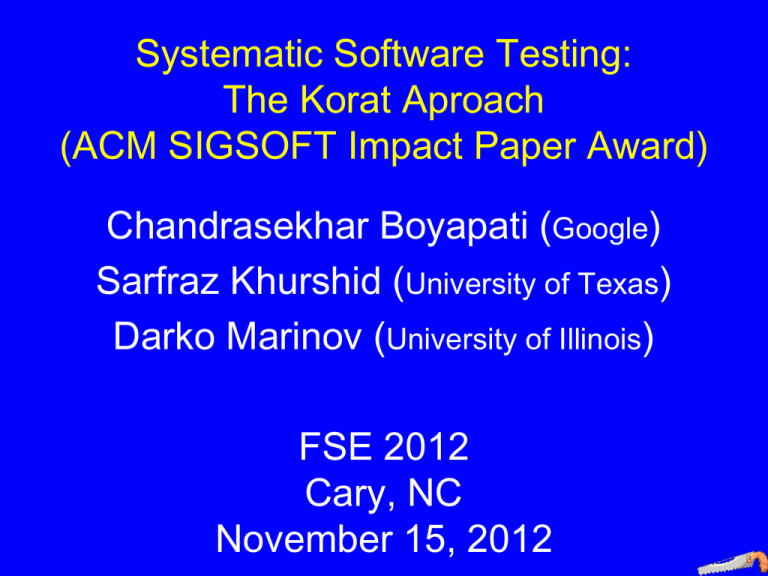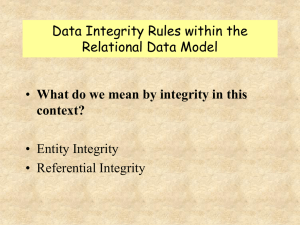PowerPoint
advertisement

Systematic Software Testing:
The Korat Aproach
(ACM SIGSOFT Impact Paper Award)
Chandrasekhar Boyapati (Google)
Sarfraz Khurshid (University of Texas)
Darko Marinov (University of Illinois)
FSE 2012
Cary, NC
November 15, 2012
Outline
• Korat overview
– Example
– Technique
– Results
• Follow-up research
• History and lessons learned
2
Examples of Structurally Complex Data
root
1
0
3
2
city
washington
building
whitehouse
service
camera
accessability
public
data-type
resolution
picture
640 x 480
wing
west
Event 0
room
oval-office
Event 1 Event 2
3
toplevel Event_0 ;
Event_0 pand Event_1 Event_2 ISeq_0 ISeq_1 FDep_0 FDep_1 ;
Event_1 be replication = 1 ;
Event_2 be replication = 1 ;
ISeq_0 seq Event_0 ;
ISeq_1 seq Event_1 ;
FDep_0 fdep trigger = Event_0 Event_1 ;
FDep_1 fdep trigger = Event_1 Event_2 ;
Event_1 dist=exponential rate=.0004 cov=0 res=.5 spt=.5 dorm=0 ;
Event_2 dist=exponential rate=.0004 cov=0 res=.5 spt=.5 dorm=.5 ;
module meta_spec
sig Signature
sig Test
static sig S1 extends Test
static sig S0 extends Signature
fun Main() {}
run Main for 3
Running Example
class BST {
Node root;
int size;
static class Node {
Node left, right;
int value;
}
…
}
4
B0: 3
root
N 0: 2
left
N 1: 1
right
N 2: 3
Example Valid Inputs
• Trees with exactly 3 nodes
B0: 3
B0: 3
root
root
N 0: 2
left
N1: 1
B0: 3
root
N 0: 1
right
N2: 3
root
N 0: 1
right
N 1: 2
N 1: 3
N 2: 3
left
N 2: 2
B0: 3
root
N 0: 3
right
right
5
B0: 3
N 0: 3
left
N 1: 1
left
N 1: 2
right
N 2: 2
left
N 2: 1
Running Example
class BST {
Node root;
int size;
static class Node {
Node left, right;
int value;
}
…
}
6
B0: 3
root
N 0: 2
left
N 1: 1
right
N 2: 3
Example Invalid Inputs
• Object graphs violating some validity property
B0: 3
B0: 3
root
root
left
right
N 1: 1
N2: 3
root
N 0: 3
N 0: 2
7
B0: 2
left
N 1: 1
N 0: 2
right
N 2: 2
left
N1: 1
right
N2: 3
Running Example
class BST {
Node root;
int size;
static class Node {
Node left, right;
int value;
}
…
}
8
B0: 3
root
N 0: 2
left
N 1: 1
right
N 2: 3
Key Challenges
1. How to formally describe valid inputs?
2. How to make they input space finite?
3. How to generate valid inputs?
9
Example Predicate
boolean repOk(BST t) {
return isTree(t) && isOrdered(t) && hasCorrectSize(t);
}
boolean isTree(BST t) {
if (t.root == null) return true;
// empty tree
Set visited = new HashSet(); visited.add(t.root);
List workList = new LinkedList(); workList.add(t.root);
while (!workList.isEmpty()) {
Node current = (Node)workList.removeFirst();
if (current.left != null) {
if (!visited.add(current.left)) return false;
// sharing
workList.add(current.left); }
if (current.right != null) {
if (!visited.add(current.right)) return false;
// sharing
workList.add(current.right); }
}
return true;
// no sharing
}
10
Example Predicate
boolean repOk(BST t) {
return isTree(t) && isOrdered(t) && hasCorrectSize(t);
}
boolean isTree(BST t) {
if (t.root == null) return true;
// empty tree
Set visited = new HashSet(); visited.add(t.root);
List workList = new LinkedList(); workList.add(t.root);
while (!workList.isEmpty()) {
Node current = (Node)workList.removeFirst();
if (current.left != null) {
if (!visited.add(current.left)) return false;
// sharing
workList.add(current.left); }
if (current.right != null) {
if (!visited.add(current.right)) return false;
// sharing
workList.add(current.right); }
}
return true;
// no sharing
}
11
Input Space
• All possible object graphs with a BST root
B0: 2
B0: 3
root
root
N0: 2
N0: 2
left
N1: 1
B0: 3
right
right
left
N1: 1
N2: 3
B0: 3
N2: 3
root
B0: 1
N0: 3
N0: 1
N0: 2
root
right
left
root
N1: 1
left
N1: 1
left
N2: 2
N2: 3
right
B0: 1
B0: 1
B0: 0
N 0: 1
root
N0: 1
root
left
right
B0: 3
B0: 3
B0: 1
N0: 3
root
N0: 1
root
N0: 1
root
right
N1: 2
N1: 2
B0: 3
N2: 3
B0: 3
N2: 1
right
N0: 1
root
N1: 3
N2: 2
12
left
right
N0: 3
root
right
left
N1: 1
N2: 2
left
right
left
Key Challenges
1. How to formally describe valid inputs?
2. How to efficiently generate valid inputs?
13
Example Input Space
• 1 BST object, 3 Node objects: total 11 fields
B0
root size
N0
null
3
3
N0
left right value
N1
left right value
N2
left right value
N1
null null
null null
3
N1
2
1
null null
1
null null
1
null null
1
N0
N0
N0
2
N0
N0
2
N0
N0
2
N1
N1
N1
3
N1
N1
3
N1
N1
3
N2
N2
N2
N2
N2
N2
N2
4 * 1 * (4 * 4 * 3)3 > 218 inputs, only 5 valid
14
Bounded-Exhaustive Generation
• Given
– Predicate
– Finitization that bounds input space
• Generate
– All nonisomorphic valid inputs up to given bound
• Simple “solution”
– Enumerate entire input space
– Run predicate on each input
– Generate input if predicate returns true
– Infeasible for sparse input spaces (#valid<<#total)
15
Bounded-Exhaustive Generation
• Given
– Predicate
– Finitization that bounds input space
• Generate
– All nonisomorphic valid inputs up to given bound
• Naïve approach
– Enumerate entire input space
– Run predicate on each input
– Generate input if predicate returns true
– Infeasible for sparse input spaces (#valid<<#total)
16
Example Input
• Each input is a valuation of fields
B0
root size
N0
3
N0
left right value
N1
left right value
N2
left right value
N1
null null
null null
N1
2
B0: 3
root
N 0: 2
17
left
right
N 1: 1
N 2: 3
1
3
Example Execution
boolean repOk(BST t) {
return isTree(t) && …;
B0: 3
}
root
boolean isTree(BST t) {
if (t.root == null) return true;
N0 : 2
Set visited = new HashSet(); visited.add(t.root);
right
left
List workList = new LinkedList(); workList.add(t.root);
while (!workList.isEmpty()) {
N 1: 1
N 2: 3
Node current = (Node)workList.removeFirst();
if (current.left != null) {
if (!visited.add(current.left)) return false;
workList.add(current.left); }
if (current.right != null) {
if (!visited.add(current.right)) return false;
workList.add(current.right); }
field accesses:
}
return true;
] N0.left
[ B0.root,
N] 0.right
[NB00[.left,
.root
[ B0.root,
]
}
18
]
Failed Execution
• Failed after few accesses for a concrete input
B0
root size
N0
3
N0
left right value
N1
left right value
N2
left right value
N1
null null
null null
N1
2
1
3
• Would fail for all inputs with partial valuation
19
Failed Execution
• Failed after few accesses for a concrete input
B0
root size
N0
3
N0
left right value
N1
left right value
N2
left right value
N1
null null
null null
N1
2
1
3
• Would fail for all inputs with partial valuation
20
Failed Execution
• Failed after few accesses for a concrete input
B0
root size
N0
3
N0
left right value
N1
left right value
N2
left right value
N1
null null
null null
N1
2
1
3
• Would fail for all inputs with partial valuation
B0
root size
N0
left right value
N0
N1
-
1 *
21
N1
-
N1
left right value
-
-
-
N2
left right value
-
-
-
3 * 4 * 4 * 3 * 4 * 4 * 3 > 212
Key Idea
• Monitor execution of predicate
• Record field accesses
• Prune large chunks of input space on each
failed execution
• Use backtracking to efficiently enumerate
valid inputs
22
Results for Structure Generation
Results from the original paper [ISSTA’02]
benchmark
23
size input candidate valid time
space inputs
inputs [sec]
BST
8
12
253
292
HeapArray
6
8
java.util.LinkedList
54418
12284830
1430
208012
2
234
220
229
64533
13139
5231385 1005075
2
43
8
12
291
2150
5455
4140
5034894 4213597
2
690
java.util.TreeMap
7
9
292
2130
256763
50209400
35
122
9
2149
java.util.HashSet
7
11
2119
2215
193200
39075006
2386
277387
4
927
IntentionalName
5
250
1330628
598358
63
Outline
• Korat overview
• Follow-up research
– Research projects
• Tool embodiment in academia and industry
– Ph.D. dissertations
• History and lessons learned
24
Since Korat: Research projects
• Lazy initialization in generalized symbolic
execution [TACAS’03]
• Data structure repair [SPIN’05, ASE’07, OOPSLA’07]
• Glass-box testing [OOPSLA’06,’08,’10]
• Parallel Korat [FSE’07 – with Google, ICST’09]
• Ranged symbolic execution [OOPSLA’12]
• Dynamic programming [FSE’12]
• Publicly available Korat tool [ICSE Demo’07]
http://korat.sourceforge.net/
• Korat part of AsmLT/SpecExplorer from MSR
25
Generalized symbolic execution
[TACAS’03: Khurshid, Pasareanu, Visser]
• Symbolic execution for primitives
• Concrete execution for references using lazy
initialization on access, e.g., consider “t.next”
E0
next next
E0
E1
null
t
E0
next
t
next
t
E1
E1
next
next
next
next
E0
E1
t
E0
next
t
E1
next
?
next
– Originally implemented using Korat code
• Source to source translation
• Shadow boolean fields to monitor field accesses
• Bound on number of objects for exhaustive generation
26
– Recently included in UC-KLEE [Ramos+CAV’11]
Data structure repair
[SPIN’05: Khurshid, Garcia, Suen]
[ASE’07: Elkarablieh, Garcia, Suen, Khurshid]
[OOPSLA’07: Elkarablieh, Khurshid, Vu, McKinley]
[ISSTA’08: Elkarablieh, Marinov, Khurshid]
• Goal: recover from runtime errors
• Approach: repair corrupt structure w.r.t. the
violated repOk – Korat + symbolic execution
binary search tree
binary search tree
1
4
2
6
27
3
5
2
4
1
5
3
6
Glassbox testing
[OOPSLA’06: Boyapati, Darga]
[OOPSLA’08: Roberson, Harries, Darga, Boyapati]
[OOPSLA’10: Roberson, Boyapati]
insert(3,x)
insert(3,x)
5
5
2
1
1
4
2
4
3
7
4
5
6
4
6
PRUNED
5
2
5
2
6
1
insert(3,x)
2
1
5
2
4
3
6
4
7
3
• Check inputs that take same execution path together
28
Parallel Korat
[FSE’07: Misailovic, Milicevic, Petrovic, Khurshid, Marinov]
[ICST’09: Siddiqui, Khurshid]
• Problem: Korat search is mostly sequential
– Search tree is highly imbalanced
• Solutions for load balancing
29
– Randomized candidate selection
– Dynamic work stealing
Ranged symbolic execution
[OOPSLA’12: Siddiqui, Khurshid]
• A concrete input encodes the state of a run of
symbolic execution analysis
• Two (in-order) inputs range the analysis run
test
30
Dynamic programming
[FSE’12: Zaeem, Khurshid]
• Writing constraints using recursive repOk’s
• Solve constraints using dynamic programming
Iter. 0:
Null
Iter. 1:
Null
Null
Iter. 2:
Null
Null
31
Null
Null
Null
Null
Korat at Microsoft Research
• Korat reimplemented as part of AsmL test tool
in Foundations of Software Engineering group
– Predicates in Abstract state machine Language
(AsmL), not in Java or C#
• Some extensions
– (Controlled) non-exhaustive generation
– Generation of complete tests from partial tests
– Library for faster generation of common datatypes
• Enabled finding numerous errors
– XML tools, web-service protocols, SSLStream,
MSN Authentication, …
32
Some Comments from Microsoft Users
• Positive comments on AsmL and Korat
Korat
is models are pretty
– “So far our stateless
AsmL
successful.”
Korat
– “AsmL parameter
generation tool is quite
convenient and powerful.”
• Negative comments on AsmL not Korat
– “Most of our testers prefer to write as much C# as
possible.”
– “Very difficult to debug AsmL.”
• Result: SpecExplorer tool for C#
33
Since Korat: Ph.D. dissertations
• Bassem Elkarablieh [UT Austin Ph.D.’09, Google]
“Assertion-based Repair of Complex Data Structures”
• Michael Roberson [U. Mich. Ph.D.’11, Microsoft]
“Glass Box Software Model Checking”
• Junaid Haroon Siddiqui [UT Austin, Ph.D.’12, LUMS]
“Improving Systematic Constraint-driven Analysis using
Incremental and Parallel Techniques”
34
Outline
• Korat overview
• Follow-up research
• History and lessons learned
35
Before Korat: TestEra
• TestEra [SOFTMC’01,ASE’01] described input
validity properties using Alloy by Jackson et al.
• Example
pred isTree(BST t) {
all n : t.root.*(left+right) {
n !in n.^(left+right)
lone n.~(left+right)
no n.left & n.right
}
}
• Advantages
– Much more succinct than repOk in Java
– Existing tool for generation (Alloy Analyzer/SAT)
36
• Challenge: requires learning a new language
Korat: Use Implementation Language
• Problem origin
– Darko presented TestEra at a group meeting
– Chandra asked if Java could be used instead of
Alloy for writing predicates
• The name repOk is from Barbara Liskov’s book/class
• Advantages
– Familiar language
– Existing development tools
– Predicates often already present
37
• Challenge: generate tests from predicates
A Bit of Korat Trivia: Name Origin
• Considered names for testing with Alloy
– TestAlloy, AlloyTest, ATest, TestA…
– TestEra
• Testing tool (Tester) using Alloy
• Precursor of CheckEra or VerifyEra
• Also: “saw” (the tool for cutting wood) in Darko’s native
language
• Natural progression to testing with Java
– Korat
• “Saw” in one of Chandra’s native languages
• Not a breed of cats
38
Acknowledgements
• We are extremely grateful for the freedom that
our advisors gave us to work on Korat
Martin Rinard
(Chandra’s and Darko’s advisor)
39
Daniel Jackson
(Sarfraz’ advisor)
• Others: Alexandr Andoni, Dumitru Daniliuc,
Michael Ernst, Viktor Kuncak, Alexandru
Salcianu, Ilya Shlyakhter, Mandana Vaziri
Korat: Some Lessons Learned
• Communicate
– There would be no Korat without an internal talk
• Collaborate
– There would be no Korat without three students
working together
– We never worried about getting “credit”
• Persevere
– Some early criticism: static analysis (in particular
shape analysis) can check the same properties
– Other “criticism”: Korat paper was first rejected
– There would be no Korat without a resubmission
40









